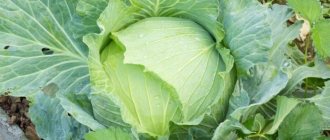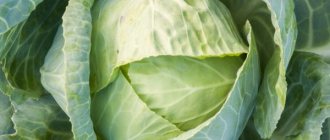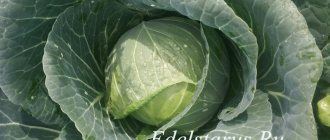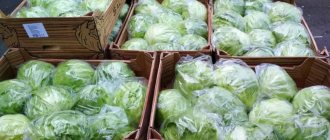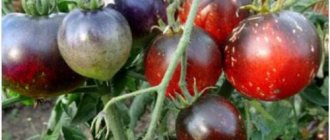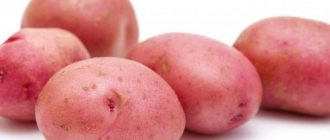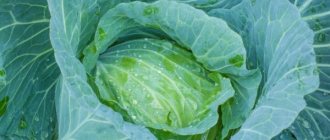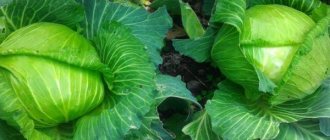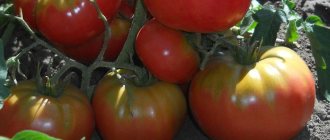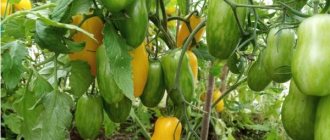Vegetable growing » Cabbage
0
1074
Article rating
Kira Stoletova
Dobrovodskaya cabbage is considered one of the most popular varieties of white cabbage. It is characterized by high yields, disease resistance and excellent taste.
Description of Dobrovodskaya cabbage
Description and characteristics
The variety of mid-late white cabbage Dobrovodskaya F1 is a first generation hybrid, as evidenced by the F1 code in the designation.
The crop is perfectly adapted for cultivation in the climatic conditions of the central and southern regions and produces large yields (12–14 kg/m²) on almost any soil, and on fertilized and fertile soils the yield increases.
Appearance of cabbage
The bush is erect, low, medium in size, with abundant spreading leaves, which requires a large growing area. The rosette is raised, sits on an elongated stem - the outer stalk - 15–20 cm high. The rosette leaves are dark green, wavy at the edges, with a natural waxy coating and large veins. The covering leaves of the head of cabbage are light green in color.
Did you know? To make the heads of cabbage grow large, in Prussia the soil under the cabbage was compacted and a large stone was placed nearby.
The root system is strong, well branched over the surface and up to 40 cm deep, fibrous in the seedling method of cultivation and tap-like in the seed method. The heads of cabbage are large, smooth, dense when cut, white inside, there are no voids. Weight can reach 6–8.5 kg, but larger specimens are also possible - up to 10 kg in conditions of fertile soil and irrigation. The inner leaves are white, juicy, sweetish in taste, the stalk is medium.
Ripening time
This is a medium-late variety - 135–155 days pass from planting seedlings to ripening. This means that after 3-4 months you can harvest. The head of cabbage takes 2–2.5 months to form.
Frost resistance
The variety is considered cold-resistant, but is not suitable for cultivation in northern regions due to the short summer and long growing season of the crop.
Cauliflower varieties
This type of cabbage is often consumed fresh, added to salads, soups, stews, and stewed . Blanks are also often made. For marinades, pickling, and various dishes, it is not the leaves that are used, but the inflorescences. Growing such a crop in open ground is very difficult. Getting a harvest largely depends on choosing the right cabbage variety. Consider the best varieties of culture.
Early
These cauliflower varieties develop heads quickly. If you don’t want to wait a long time for the harvest, then pay attention to the best seeds:
Ripens 60 days after transplanting. Resistant to cold and drought. Inflorescences are white, yellowish-white, weighing up to 1400 g, without bitterness. Due to the short ripening period, the harvest can be obtained 2 times per season. There are no cons.
"Snowball 123" or "Snow Globe", 0.5 g
They were taken out by French selection workers. The heads are dense, weighing up to 2000 g, without bitterness, and ripen in 100 days. Suitable for growing in greenhouses and open ground. Rarely affected by disease. Minus - it is difficult to tolerate drought and lack of fertilizing.
"Fremont F1", 0.1 g
The hybrid was brought out by workers. The heads weighing 1.5 kg set quickly, are distinguished by their high density, smoothness, excellent taste, and ripen 78 days after transplanting to a permanent place. There are no germinating top leaves. There are no cons.
Late
Harvesting takes place in late autumn - in mid or late September. Some heads can be cut off in early September. The best varieties of cabbage are Lennox, Megaton F1 and the following:
"Skywalker F1", 0.1 g
The ripening period is 90 days. Productivity – 6 kg/sq.m. m. It is distinguished by dense heads of 3 kg, which are covered with leaves. The taste is fresh and pleasant. The downside is the high cost of seeds.
They were taken out by workers from the Dutch farm Syngenta. Maturation time – 75 days. The heads are covered with leaves and weigh 2 kg. The pulp is juicy and has excellent taste. There are no cons.
Agricultural technology for growing the variety
To get a good cabbage harvest, you need to know agricultural technology and the features of caring for this crop:
- the need for irrigation is moderate during the seedling period, increases during the formation of heads of cabbage;
- culture of long daylight hours;
- Crop rotation must be observed.
Soaking seeds for sowing
Cabbage seeds need pre-sowing preparation, which promotes uniform germination, the growth of healthy seedlings and an increase in yield by 20%.
Such preparation includes:
- heating the seeds on a heating radiator (1 day) or treating them with hot water (+50°C, 15 minutes);
- disinfection (increases resistance to harmful lesions) - soaking for half an hour in a pale solution of potassium permanganate, infusion of chamomile, oak bark or aloe juice with further rinsing;
- treatment with special growth regulator solutions - soaking for 12 hours in Zircon, Albit, Energen, Epin, nitrophosk (5 g per 1 liter of water).
After this, the seeds can be placed in the freezer for a day for hardening, wrapped in a damp cloth.
Important! Seeds of different types and varieties of cabbage, as well as rapeseed, mustard and turnip seeds are no different in appearance. Cultures can be distinguished only by their shoots. Therefore, it is important to buy planting material indicating the varieties in specialized stores.
Further care of seedlings
Treated seeds are sown to produce seedlings in March or early April:
- into seedling trays by continuous or line sowing with further picking of sprouts in the cotyledon phase;
- in separate cups - 2-3 pieces each with further rejection of weak sprouts.
The sowing depth of the seeds is 1.5 cm. Until the shoots appear, you need to keep the trays at a temperature of +18...+20°C, covering them with film. Light is not required for germination. The first loops of sprouts appear on the 4th day and unfold the cotyledons.
The roots reach 12–15 cm, and lateral roots begin to form. A week later the first true leaf appears. A week passes between the formation of each subsequent leaf. Using these indicators, you can determine the time of planting seedlings in the ground.
For the normal development of seedlings, temperature and illumination are very important:
- In the first days after germination - +7...+10°C to prevent the seedlings from stretching.
- 1 week after germination - +15...+18 °C. During this period, you can carry out a pick.
- Good daily illumination - for 16 hours. If necessary, illumination with phytolamps will be required.
Important! If it is not possible to create the necessary conditions in the apartment, then you can sow seeds for seedlings directly on the site, choosing the warmest place and building a temporary film greenhouse.
To ensure that the seedlings are squat and strong, and the roots develop faster and grow lateral roots, seedlings are picked into separate cassettes according to the 3x3 cm pattern, deepened to the cotyledon leaves.
Growing seedlings require regular watering and spraying, but cannot tolerate waterlogging. It is necessary to ensure that the earthen ball is always moist and does not dry out. And to avoid rotting of the roots and stems, the soil must be loosened frequently and the seedling trays must be provided with good drainage.
It is advisable to feed the seedlings three times before transplanting into the ground with ready-made mineral fertilizers (“Kemira Lux”) or a personally prepared solution per 1 liter of water.
Check out
How to plant and grow cabbage correctly
Solution composition:
- ammonium nitrate - 2 g;
- potassium nitrate or potassium chloride - 2 g;
- superphosphate - 4 g.
The first feeding is needed 1 week after picking. The second and third applications of nutrients are carried out at intervals of 2 weeks. The dose of potassium fertilizers in the third feeding (called hardening) is increased to 8 g for better adaptation of seedlings in open ground.
It is also worth carrying out foliar feeding by spraying plants with solutions of Kemira and Agricola preparations. 2 weeks before planting seedlings in open soil, you need to start hardening it, lowering the temperature to +6...+ 8°C. The seedlings are first taken out into the air for several hours and the hardening time is gradually increased to 1 day.
Preparing the site and soil in the garden bed
The area for cabbage should be level and sunny. It is better to prepare it in the fall, then you won’t have to waste time during the hot sowing season in the spring. The bed is dug to a depth of 25–30 cm, and organic fertilizers are added.
In spring, the area should be leveled, a mixture of mineral fertilizers should be added (per 1 m²) and watered:
- superphosphate or nitrophoska - 50 g;
- wood ash 200 g;
- urea - 10 g.
Important! The causative agent of a fungal infection called clubroot remains viable for 7 years.
If stagnation of melt or rain water is possible on the site, then the beds should be raised and ridges formed. It is necessary to observe crop rotation and not plant cabbage in the same place for 4 years due to possible soil depletion, accumulation of pests and pathogens.
The best site for mid-late cabbage will be places where cucumbers, early potatoes, carrots, pumpkins and legumes grew. Avoid areas where beets and cruciferous vegetables grow.
Transplanting seedlings into open ground
Seedlings are planted in May-June at the age of 50–55 days with 4–5 true leaves unfolding. The soil should warm up to +7…+12°С. You can add 1 bucket of compost to the hole under each bush.
Did you know? Everyone knows the Pythagorean theorem, but not everyone knows that the famous mathematician valued cabbage for its medicinal properties and was engaged in its selection. And the Roman emperor Diocletian abandoned the throne and began growing cabbage.
Plant the seedlings in moist soil. Planting pattern - 60x50 cm, density - 2-3 bushes per 1 m². Stretched seedlings can be slightly buried to the lower leaves. It is better not to bury squat and strong shoots in order to protect the lower leaves from rotting during cool and humid periods.
Young seedlings can suffer from the hot sun, so planting in the first days should be shaded with branches of deciduous trees or woven material. You can cover each bush for the first time with an inverted bucket or a cut plastic bottle. Lettuce is sown in the free space or additional cabbage seedlings are planted for replacement if any sprouts die.
What is cabbage? Description, varieties and features of growing this vegetable
You may or may not like cabbage, but we can’t help but agree that it is one of the most popular vegetables in the world. Easy to grow, with a long shelf life, cabbage is used to prepare many tasty and healthy dishes. It is rich in vitamins, micro- and macroelements.
Cabbage belongs to the cabbage family. Leaves tightly adjacent to each other are collected into a head of cabbage. Some species consist of inflorescences that form the apex.
Hide content
What is it and what does it consist of?
The brightest representative of the family is common white cabbage.
The dense head of light green color is an overgrown apical bud . It consists of large concave leaves and is formed around the stump - the stem of the plant.
The stump inside the head of cabbage is called internal, and the one coming out of it is called external; root shoots branch off from it. There are small buds at the base of the leaves.
Plant life cycle
Among the representatives of the cabbage family there are both annual and biennial plants .
- Annual representatives (broccoli, cauliflower) produce seeds every year.
- In the first year, biennials develop a short, thick stem with a head of cabbage. If it is not cut, in the second year a shoot grows from the inner stalk, on which fruits are formed from the flowers, and then small, round brown seeds.
What are the characteristics of the cabbage family?
In addition to various types of cabbage, there are other representatives in this family, for example, mustard, gailan, as well as root vegetables - turnips, turnips, rutabaga .
Rutabaga is a hybrid of turnip and cabbage. The root vegetable has a round shape and light, dense pulp with a sweetish taste. Rutabaga is eaten both raw and cooked. The product goes well with various vegetables; salads and first courses are prepared from it.
Useful qualities are provided by the high content of vitamin C, which is resistant to heat treatment, as well as calcium. The juice heals wounds and burns well. Some varieties of rutabaga are grown to feed domestic animals and birds.
Benefits and harms
Let's consider whether this vegetable is healthy or not. In addition to food, cabbage is of great value as a medicinal plant , due to its rich chemical composition:
- In addition to carbohydrates and carotenoids, it contains vitamins - ascorbic acid, thiamine, riboflavin, folic and nicotinic acids.
- Also present is biotin (vitamin H), tocopherols, vitamin K, mineral salts, trace elements and free amino acids.
Eating cabbage has a beneficial effect on digestion, removes excess fluid from the body, and also normalizes blood sugar and cholesterol levels. The calorie level is low, cabbage can be used for dietary nutrition .
Cabbage juice is used in cosmetology to prepare masks, as it has a rejuvenating effect.
Important ! Despite all the advantages, it is not recommended to eat cabbage during periods of exacerbation of gastric ulcers, as well as for people suffering from intestinal spasms, increased peristalsis or enterocolitis.
Considering the wide variety of representatives of this cultivated plant, everyone will be able to choose the ideal type for themselves according to their culinary preferences.
Broccoli
Dark green dense inflorescences on thick juicy stalks, an excellent source of vitamins and nutrients. Broccoli removes heavy metal salts from the body and is considered an effective remedy for the prevention of cancer.
Colored
Cauliflower is a dense head formed from white inflorescences, similar in shape to broccoli. An excellent source of ascorbic acid, contains iron, potassium, selenium, iodine and B vitamins.
Just one serving of cauliflower (200g) fully meets the daily requirement for vitamin C and B9.
Beijing
The juiciest variety with heads of oblong leaves with fleshy, wide, flat veins. Chinese cabbage is ideal for preparing salads due to its pleasant taste and crunchy properties. Contains a large amount of lysine - an amino acid that can dissolve foreign proteins, cleanses the blood, and improves immunity.
bok choy
Bok choy or Pak choy is a variety of Chinese cabbage with dense stems and smooth leaves growing around a central bud. Heads of cabbage are not formed. It has a low calorie content, but at the same time satisfies hunger well and normalizes metabolic processes in the body.
White cabbage
Common cabbage is one of the most popular garden crops, unpretentious to soil characteristics and weather conditions. Contains vitamins, fiber and dietary fiber , which is why it is often used in the preparation of dietary diets. Domestic and foreign breeders are constantly developing new varieties.
Aggressor
Aggressor is one of the late-ripening white cabbage varieties, bred in Holland, adapts to growing conditions. It has good seed germination and an attractive presentation.
Glory
Slava is a mid-season variety that is grown everywhere due to its ability to withstand any weather. The vegetable is perfectly stored without losing its hardness and tolerates transportation well.
Megaton
This frost-resistant variety has high yield and immunity to fungal diseases. Megaton contains a lot of sugar, so it is well suited for fermentation.
Romanesco
Romanesco is the result of crossing broccoli and cauliflower. The head is represented by green swirling inflorescences, each of which consists of smaller inflorescences forming a spiral. Improves the elasticity of the walls of blood vessels and intestinal function, removes toxins.
Red cabbage
This late variety differs from cabbage in the blue-violet color of its leaves due to its anthocyanin content. Red cabbage is recommended for the diet of people with hypertension and heart disease; it stabilizes cholesterol and lowers blood pressure. Low calorie content promotes weight loss.
Cale
An annual plant with curly leaves on petioles. Kale comes in different colors - green, red, purple and shades thereof. Does not form heads, continues to bear fruit after cutting the leaves. It has a higher iron content than beef, but is easy to digest.
Japanese
An exotic variety with a delicate taste. The composition is very similar to Beijing. Due to its spectacular appearance, Japanese cabbage often grows in flower beds.
Savoy
Savoy cabbage is similar to white cabbage in the shape of its heads, but has ruffled, tender leaves with a sweeter taste. Resistant to diseases and pests, late varieties are cold-resistant.
Kohlrabi
The stem fruit is round in shape and green or purple in color. Kohlrabi lowers blood pressure and cholesterol and is a dietary product due to its low calorie content.
Decorative
A lush, spectacular rosette from yellow, pink to deep purple will be a bright decoration of any landscape until winter, since this plant can withstand slight frosts. At the same time, ornamental cabbage can also be eaten.
There are many varieties of ornamental cabbage, the names and descriptions of which you can find here, and read about the secrets of growing them in this material.
Growing
The seedling method is usually used for growing cabbage. First, seedlings are grown, which are then transplanted to a permanent place.
It is very important to observe the timing of sowing seeds and transplanting into the ground, temperature and light conditions, and timely watering and fertilizing of plants.
Cabbage diseases include:
- Fungal infections . They are eliminated by spraying with fungicides and removing the affected areas of plants.
- Pests . To protect the crop from the cruciferous flea beetle, wood ash is used; chemicals can be used to control the caterpillars or the pests can be collected manually.
- Rotten . They occur due to excess moisture and poor ventilation. You can find a large number of products on sale to combat this disease.
Harvest and storage
The timing of the cabbage harvest depends on its variety. Early varieties ripen at the end of June. Late species are harvested at the first frost.
For winter storage it is best to use late varieties. The optimal place would be a pantry, cellar or basement with a temperature close to 0 ° C and a humidity of 85-95%. The room must have good ventilation and the absence of fungi and mold.
Cabbage is one of the most accessible sources of vitamins in our time. Its daily presence on the table will help replenish the deficiency of nutrients in the body, improve the health and well-being of all family members.
Interesting video
We offer a video review of the types of cabbage that you can grow on your site:
Source: https://nasotkah.com/ovoshhi/kapusta
Features of caring for cabbage
The best indicators of yield and product quality are observed if the plant receives the necessary full care.
Watering and fertilizing
In order to grow heads of cabbage weighing 10 kg, you need a lot of nutrients. With a lack of mineral fertilizers, plant growth slows down, and the heads of cabbage set poorly and grow small.
Fertilizer rates should take into account the stages of crop development, soil structure and fertility. At least 3 feedings should be carried out per season. The first feeding in the seedling phase is carried out 10 days after planting.
Can be used:
- organic matter per 1 m² - 3 kg of mature humus or 2 kg of bird droppings.
- 0.5 kg of cow manure or bird droppings per 1 bucket of water with a flow rate of 500 ml for each bush;
- potash fertilizers and superphosphate (20 g each) with the addition of urea (10 g) per 1 bucket of water;
- solution of humic fertilizer “Living force: Vegetable abundance”, “Agricola 1”, “Kaliyphos N”.
Further feeding is done at intervals of 2 weeks.
The second feeding is carried out when the leaf mass increases; nitrogen in the fertilizer is important here. The composition of nutritional mixtures and consumption rates are the same. The third feeding occurs during the head formation phase. In this case, phosphorus and potassium fertilizers (monophosphate or potassium nitrate, nitrophoska) are necessary. Subsequently, with weak growth, it is fertilized 1–2 times with a solution of nitrogen and potassium fertilizers. To do this, dry mineral fertilizers are mixed with irrigation water and combined with shallow loosening.
The variety needs frequent and abundant watering. Every 3 days, depending on weather conditions, drip irrigation or sprinkling is carried out with a consumption of 3 liters of water per bush.
Read more
How often to water cabbage Water the cabbage with warm, sun-warmed water in the morning or evening so as not to burn the plants in the midday heat.
It is good to water with rainwater if its collection is established in the area.
Before harvesting cabbage, watering is reduced, and 1 month before harvesting is stopped completely to avoid cracking of the cabbage heads.
Loosening and weeding
Loosening the soil allows you to improve the moisture and air permeability of the soil. It should be carried out after rain or watering so that the soil does not become covered with a crust, which makes it difficult for nutrients to reach the roots.
The first loosening (deeper, 7–10 cm) is done during the period of active weed growth - 10 days after planting the seedlings. Then the depth is reduced to 3–5 cm so as not to damage the surface roots. The row spacing is loosened to a depth of 8–10 cm.
Loosening is combined with weeding, removing weeds from the beds, which take away nutrients from the cabbage (up to 30%), shade the plantings and create favorable conditions for the spread of harmful lesions.
Hilling up bushes
Along with loosening during cabbage growth, bushes are hilled in order to form additional lateral roots, improve nutrition and ensure plant resistance to lodging and overturning, which is possible with increasing cabbage weight. In addition, pests will not have the opportunity to lay eggs near the roots.
Timely hilling can provide a 10% increase in yield. The event is carried out within a radius of 25 cm from the root, adding soil to a height of 30 cm. After hilling, you can mulch the rows, which will make it possible to reduce the frequency and volume of watering.
How to grow cabbage seedlings in a greenhouse
Stages of growing cabbage seedlings in a greenhouse
Obtaining high-quality seedlings in a greenhouse has its own characteristics that need to be taken into account, taking into account the main stages of growing these plants:
Careful selection of cabbage varieties and hybrids
Not every variety or hybrid can produce good seedlings in a greenhouse, so you need to choose only those varieties that are specially bred for growing in such places. You need to select:
- high-quality seeds (varieties rather than hybrids are better suited for growing seedlings in a greenhouse);
- seeds of early, middle and late varieties.
Preparing soil in a greenhouse
For growing cabbage seedlings in a greenhouse, ordinary fertile soil is quite suitable, but it is better to mix it with peat and ash in the calculation:
- 4 parts fertile soil;
- 1 part peat;
- 1 kilogram of wood ash, for the entire area allocated for a greenhouse.
Choosing the optimal timing for sowing cabbage seeds
For cabbage with different ripening periods, different seed sowing times are needed:
- seeds of early varieties can be sown from the end of March to mid-April;
- seeds of medium varieties of cabbage can be sown from the beginning of April until the end of the month;
- seeds of late varieties of cabbage can be sown from early April to early May.
Sowing cabbage seeds
Cabbage seeds must be dry before sowing in a greenhouse. Cabbage seeds should be sown in the following sequence:
- First you need to make the required number of lines, the distance between which should be from 15 to 20 centimeters, and the depth should not be more than 3-5 centimeters.
- After this, the lines must be watered abundantly.
- High-quality seeds should be sown sparingly (there should be 3-5 per 1 centimeter square).
- After sowing, the rows need to be sprinkled with soil, only so that the seeds are immersed to a depth of no more than 2 centimeters and no less than 1 centimeter.
- Each line with a new variety must be marked with a flank with the appropriate inscription.
Caring for cabbage seedlings in a greenhouse
After germination, young seedlings need careful care:
- The greenhouse must be tightly insulated to ensure optimal temperature both during the day (16-20) and at night (10-12).
- Seedlings need to be watered in a timely manner so that the soil does not dry out.
- When the first true leaves appear (earlier if necessary), you need to treat the cabbage seedlings with an insecticide against cruciferous flea beetles.
- When the seedlings have 4 true leaves, you need to add a 3-5 centimeter layer of soil, sand, peat or fine sawdust to the greenhouse. This is done so that the seedlings form an even stem.
- If the seedlings in the greenhouse are too dense, they need to be thinned out. To do this, poorly developed seedlings are pulled out or cut off at the root. After thinning, the seedlings need to be watered abundantly.
- If necessary, you can spray the seedlings after 1-2 weeks with a solution of biofertilizers. This way the seedlings will develop better and faster.
Hardening off cabbage seedlings
Hardening is vital for cabbage seedlings grown in a greenhouse. It is carried out in 3 stages:
- The first stage begins when the daily temperature is above 15 degrees. Then, on sunny days, the seedlings should be opened first for 15 minutes, and then every week the time should be increased by 10-15 minutes, depending on the weather.
- The second stage begins when, even at night, the temperature does not drop below 8 degrees. Then you need to leave a small window in the greenhouse all day and night for constant air ventilation. In addition, the seedlings need to be opened completely for 1-2 hours.
- The third stage begins 1-2 weeks before planting seedlings in open ground. Then the seedlings should be completely open for most of the day.
Planting cabbage seedlings in open ground
Growing seedlings in a greenhouse ends with planting them in open ground. This must be done following the rules:
- Pull out seedlings only when the rows are watered abundantly.
- It is advisable to transplant cabbage seedlings on a cloudy day or in the second half of the day, when the sun is already close to sunset.
- For better survival, it is advisable to treat the roots of seedlings with growth stimulants.
- The holes need to be watered generously.
- It is advisable to mulch the soil of the seedlings so that the moisture does not evaporate quickly.
As some experience of gardeners shows, it is easier to get high-quality white cabbage seedlings in a greenhouse, even with minimal care and expense. But at the same time, in no case should we forget about pests such as cruciferous flea beetles. It is imperative to protect the seedlings from them in a timely manner so that it is not too late, otherwise these pests can destroy young seedlings in a few days. All other procedures for growing cabbage seedlings are similar to growing any other seedlings.
Pest and disease control
The Dobrovodskaya cabbage variety is immune to pathogenic infections: fusarium, black and dry rot, blackleg, fomosis and bacteriosis, is not affected by cruciferous flea beetles, but gets clubroot under unfavorable conditions and violation of agricultural practices
Clubroot most often develops on acidic soils, so if necessary, liming should be done (per 1 m²) with dolomite flour (800 g) or ash (250 g). This fungus does not like nightshade and onion crops and dies on such plantings in 3–4 years. In case of damage, it is necessary to spray the bushes with colloidal salt (10 g per 1 bucket of water) or use the fungicides “Previkur”, “Fitosporin-M”, “Glyokladin”.
To protect your plantings from cabbage whites, you can cover the bed with a thick net - this will help prevent egg laying. For preventive purposes, the garden bed can be sprinkled with ash. The cabbage must be carefully inspected and when caterpillars appear, they must be collected and destroyed.
Aphids can be destroyed by spraying the bushes with a soapy solution of tobacco (50 g of soap, 400 g of tobacco per 1 liter of water), or by using copper-containing preparations “Oxychom”, “Epin”.
When cabbage flies appear, the bushes are treated with the drug “Bazudin”, and against slugs - “Meta”, “Metaldehyde”, or sprayed with a solution of copper sulfate (0.5%). The preparations must be changed periodically, and diseased and affected parts of the plant must be removed and burned.
Reviews from summer residents
Vladislav Ivanovich, Yekaterinburg, 39 years old.
The cabbage is very good. The heads of cabbage grow large and do not crack. We use it fresh and ferment it. Moreover, fermented Dobrovodskaya is something with something. Juicy, tasty, crispy.
Oksana Vladimirovna, Kyiv, 43 years old.
No matter how many varieties I have grown, I have never seen anything better than Dobrovodskaya from Semko. Some friends once told me that the Moscow late one is very good, but I still can’t buy it and try it. I’ll return to Dobrovodskaya again. Cabbage is good in everything, but I just don’t like that the heads of cabbage are too big. You can’t really eat it at once, and it’s not always convenient to keep half a head of cabbage in the refrigerator (considering the dimensions of 10 kg). But even despite such dimensions, not a single head of cabbage in my garden cracked. And this is a plus.
Dobrovodskaya cabbage is considered one of the most popular varieties of white cabbage. It is characterized by high yields, disease resistance and excellent taste.
Description of Dobrovodskaya cabbage
Features of harvesting and storage
The mid-late variety Dobrovodskaya F1 is harvested in one go when the heads of cabbage reach commercial maturity and based on the growing season. This is usually October or early November, when the average daily temperature drops to +2°C. But the heads of cabbage should be protected from freezing.
Important! determine the ripeness of cabbage
by its appearance by the yellowing of the lower leaves and the appearance of a light spot on the surface in the center of the head of cabbage.
It is necessary to leave covering leaves on the heads of cabbage to protect it from damage. The harvest is processed (fermented, pickled, dried) or the vegetable is used fresh, since the variety is not intended for long-term storage. In a cool room, heads of cabbage can only be stored for 1.5–2 months.
By choosing the Dobrovodskaya F1 cabbage variety to grow on your plot and following all the rules of agricultural technology, you can ensure a good harvest of this vegetable with excellent taste and prepare a lot of sauerkraut for the winter.
Appearance of cabbage: main selection criteria
So, let's find out what the ideal cabbage for harvesting should be:
- The larger the head of cabbage, the better! Large vegetables have much more juice.
- No green leaves, only white ones. The fact is that it is the white leaves that contain enough sugar, which is so necessary for fermentation.
- No bitterness, only sweetness! You should not use cabbage, which is bitter, for preparation; be sure to try a piece while shredding.
- Density and crunchiness are the key to success! The denser and juicier the head of cabbage, the tastier the final product will be.
- The best test method is to squeeze the leaves. If a lot of juice is released, then the variety is suitable.
Care instructions
The best yield indicators are observed if the plant receives the necessary full care.
Watering
The variety needs frequent and abundant watering. Every 3 days a drip is made. One bush requires at least 3-4 liters of warm water for better adhesion of the roots to the soil.
Loosening
After each watering, the soil is loosened and the beds are weeded to remove weeds. Loosening the soil allows you to get rid of the crust on the top layer of soil, which does not allow air and necessary nutrients to enter the root system. The weeding depth should be 5-6 cm.
Top dressing
Fertilizers are first applied 20 days after planting seedlings in open ground. Use organic matter: per 1 sq. m add 3 kg of humus or 2 kg of bird droppings.
The second feeding is carried out when the fruits are set. To prepare the product, dilute 20 mg of superphosphate and 10 mg of ammonium nitrate in 10 liters of water. 1 liter of solution is poured under each bush.
The third feeding, using potassium nitrate (30 mg per 10 liters of water), is carried out 15-20 days before harvesting. One bush needs 1.5 liters of the substance.
